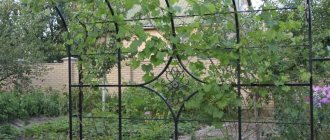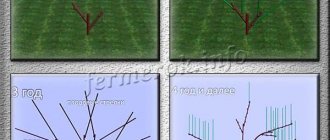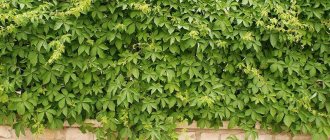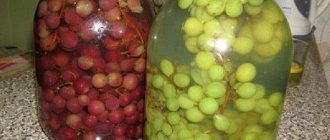Previously, country lands were used exclusively as garden plots for growing home-grown vegetables and fruits - if not for sale, then for additional food for family members. Today, such private properties often serve as places of relaxation and relaxation. Previously unfamiliar to most Russians, the pergola for grapes, shown in the photo below, makes it easier for summer residents to care for and grow this fragrant gift of Mother Nature.
What was it used for before?
Previously, people often used this method to hide from the sun, especially in hot countries. In the eighteenth and nineteenth centuries, such gazebos played the role of garden decorations. Now pergolas can be found in summer cottages and garden plots, as decorations for parks and squares; they are a beautiful addition to almost any composition.
If you don’t have a lot of space on your plot, then the ideal solution is to grow grapes upward. In this case, the plant will receive a sufficient amount of sunlight and heat, thanks to which the yield improves and the clusters ripen faster. Undoubtedly, it will be better for the grapes if natural ventilation is provided; it is necessary to reduce the likelihood of infection with various diseases. Due to this, the need to use chemicals to treat plants is reduced.
About the pergola
A pergola is a garden structure designed for climbing plants. It can simultaneously serve as a canopy and sun protection for a terrace or transition between buildings or parts of the garden. With its help, you can perform zoning of the site, creating a special atmosphere. In view of the universal purpose of the design we are considering, we should think about what its main purpose will be.
This is interesting: Currants and gooseberries in the fall - proper care and preparation for winter: pruning bushes in the fall
Here are the possible options:
- To decorate the garden and change the look of the landscape.
- As a support for climbing plants (grapes, hops, ivy, climbing roses).
- It will protect from the sun, creating shade over the terrace or over the parking lot.
- For relax. In this case, the pergola can be combined with a bench or gazebo.
- If it is necessary to hide some area of the garden from prying eyes, then zoning is performed.
Canopy - pergola near the house made of grapes - dense shade even at midday
Purpose of the pergola
Initially, such canopies were used as a support for grapevines. However, with the transformation of suburban areas from gardening estates into recreation areas, the functions of the pergola have expanded significantly:
- Such landscaped structures perfectly protect country paths from precipitation, protecting certain sections of the territory from the indiscreet glances of curious neighbors.
- A pergola attached to the house, made in the form of a canopy, will help in the scorching sun to do without heavy curtains and blinds. How pleasant it is to pamper yourself with fragrant grapes, reaching out of the window and easily picking an alluring bunch.
- Alternatively, such arches can protect from rain, providing a shaded safe passage between the pavilions of the garden. By decorating the pergola with fragrant plants like roses, you create a truly paradise with your own hands.
- By installing several comfortable seats in the pergolas in the form of benches or even ordinary sun loungers, it becomes possible to use green arches for family leisure and enjoy relaxing in nature without fear of sunburn.
What are there
In ancient times, pergolas were not only found in vineyards. Similar structures, only on a larger scale, were made in courtyards to protect from the scorching sun. The hottest midday hours were spent under them. They were more like canopies, one part of which rested on the wall. Their design remains the same, the materials have changed: now a pergola can be not only wooden, but also metal, concrete and even plastic.
In addition to being a useful structure - supporting vines and creating shade - it is also beautiful. The architects appreciated this. Gradually, pergolas migrated to the gardens of the nobility. Only there they had a more refined shape, expensive materials were used, including marble columns, and beams were made in elaborate shapes. Not only and not so much grapes were climbing over them, but also ornamental plants, roses, bindweeds and vines.
This is also a pergola, but the appearance and design are completely different, although the construction principle is the same
They also make it in the form of a gallery, blocking it from the sun all the way from one building to another. These arcades serve as a support for perennial vines and climbing roses. Where they cannot survive due to the harsh climate, annual bindweeds can be used; they are no less decorative; the flowering period can be selected so that flowering continues throughout the warm season.
An entire gallery of arches can cover the path from one building to another or to a recreation area
In the modern sense, it is more like a canopy or an open summer gazebo, which instead of a roof has a network of beams along which plants climb.
Concrete pergolas require careful calculation.
And this too. This is more like a summer gazebo for a pleasant time.
Non-standard design. Nevertheless, this is also a type of pergola.
So, with the help of a pergola, you can decorate the entrance to the house - it’s a canopy that looks good even without plants, and when they grow it will be even more comfortable.
A modified pergola is also an arch on which flowers or grapes rest. If we say “arch,” then most often we mean a metal product with a rounded upper part.
An arch for grapes is also a pergola, only with a modified shape of the upper part.
An arch under a climbing rose is the same pergola. But the mass of a rose is less than that of a grapevine and wooden structures are also made for it.
Hang flowerpots with hanging plants on top - and the arch becomes even more elegant.
Powerful columns were entwined with vines - a protected garden.
Blooming honeysuckle on an arch-pergola.
DIY pergolas for grapes made of wood
Perhaps this is the most popular type of such buildings for grapes. It is quite inexpensive and easy to use; a tree such as: 1) pine will do; 2) aspen; 3) spruce; or 4) oak.
Advantages of a wooden pergola for grapes.
The grapes look advantageous and natural against the background of the tree, and the tree also contributes to the correct formation of the vine. A wooden gazebo shrouded in grapes will look attractive on any site.
Disadvantages of a wooden pergola for grapes.
The downside of wood is its ability to rot. The grapes need to be watered and this can ruin the gazebo. But with the help of various solutions: 1) copper sulfate; 2) kerosene and resin can preserve the original appearance of the tree.
What needs to be done to make a wooden pergola for grapes last a long time.
In order for the wood to work for a long time and not deteriorate, before constructing the structure it must be completely dried, then treated with an antiseptic solution. To prevent deterioration of the material, it is recommended to carry out such treatments annually.
What will help with a high percentage of humidity.
Various varnishes and special paints help against rain and getting wet; they can also prevent damage to wood by pests and fungi. Before processing, you need to dilute the varnish or specialized oil with a dye to match the color of the pergola.
Maiden grapes in landscape design
Vineyards in garden decoration are primarily used to create decorative fences. Many summer residents, gardeners and winegrowers specifically plant vines as cheap decorations for various fences.
Note! The structures must be extremely stable, because the vines have a lot of weight. It is best if the girl’s grapes are supported by an iron mesh, tightly stretched between two concrete pillars
The main thing is that it does not sag, otherwise it simply will not hold up, and the plant will collapse to the ground, the branches of which will be problematic to attach back to the trellis
It is best if the girl’s grapes are supported by an iron mesh, tightly stretched between two concrete pillars. The main thing is that it does not sag, otherwise it simply won’t hold up, and the plant will collapse to the ground, the branches of which will be difficult to attach back to the trellis.
But the metal mesh does not always have the proper aesthetic properties, and the girl’s grapes, although they differ in their growth rate, do not grow up to several meters in an instant. Therefore, it is quite acceptable to use a strong wooden fence or lattice, which is installed on strong beams. If it starts to sag, you can install supports, the result will be an object resembling ruins.
Important! Parts of wooden structures in contact with the ground must be treated and protected from moisture and rot. Metal and concrete pillars do not need such treatment
A wonderful idea for creating a landscape composition would be an arch decorated with a vine. However, you should be careful not to install a similar structure near other plants. This is because the girl’s grapes compete with neighbors who are planted at a distance of 7 m from them. And constant pruning to give shape will not help here.
Many designers use vines to decorate pergolas. This is a type of gazebo, but without a roof. It is replaced by a lattice fence made of vinyl, metal or wood. The grapes, entwining the roof structures, form a shady and cozy canopy, creating an atmosphere of mystery and comfort in the garden plot. The size of the pergola can be different, it all depends on the surrounding design and the gardener’s imagination.
Create beauty with your own hands
Maiden grapes are an unpretentious plant, but this feature depends on the variety and planting location. On the sunny side, the leaves of the vine are painted in a dark red, almost crimson color, and in the shade the plant will delight with a dark green, emerald color
If the inconsistent palette of grapes, so indispensable in landscape design, does not suit you, then you should pay attention to varieties that are resistant to sunlight. For example, the Boston ivy variety will constantly delight you with its emerald color
DIY metal pergolas for grapes
Pergola for grapes: photo
Pergolas for grapes are not built from metal as often as from wood, but it is in demand. As a rule, metal is more difficult to assemble (you will need the help of a specialist) and more expensive to purchase. Despite this, metal structures are more durable and less vulnerable than wood.
You can use metal as the frame for the gazebo, or you can add metal elements to wood or other structures. Simple metal gazebos and structures can be easily assembled yourself.
What can be used as a metal pergola for grapes
Nowadays, profile pipes are often used to build metal pergolas for grapes. Since metal is flexible and soft, it can be bent or forged if desired and possible. Such home-made or purchased elements can be supplemented with a metal frame.
What to do to avoid rust.
To avoid the appearance of rust stains, it is recommended to treat the structure with a primer and paint over the entire surface. To make the structure feel like one with the vines, you can paint the metal in shades of green. To make the pergola more delicate and lighter, you can paint the frame of the structure white or light green.
Varieties
Structurally, columnar and arched types are distinguished. They are made of metal, wood or plastic. By experimenting with style, you can come up with supports that match the surrounding objects or stand out from the general background.
Straight columnar
This is the simplest option, requiring a minimum investment. It is a chain of steel pipes (channels, logs) dug into the ground at a certain pitch. Copper and stainless steel wire, nylon cords, and fishing line are pulled between them.
Such devices are divided into:
- Single. Positive aspects - low cost, good ventilation of foliage, uniform ripening of bunches, free access for work (pruning, crown formation). There is also a drawback - the emergence of powerful sleeves that are difficult to handle.
- Double. Such supports for grapes are made in the form of parallel, V-shaped, T-shaped or Y-shaped posts. They are suitable for large grape plantations and contribute to better pollination.
Trellis-arch
The arched, semi-arched shape allows you to simultaneously grow several varieties of grapes. The green mass grows under conditions of optimal illumination and ventilation. A recreation area is often placed in the shade under cover, with tables, seats, and swings installed.
Despite all its beauty, there is one caveat - to harvest from the top you will need a stepladder.
Plastic as a material for a pergola.
Pergola for grapes: photo
This is the most budget-friendly and worst option for making pergolas. Despite this, plastic is most in demand due to its low price, ease of use and the ability to make a pergola of almost any shape.
In flower and garden stores you can purchase ready-made structures for grapes. Plastic does not always immediately fit perfectly into the design of the area, but when the grapes cover the structure it will be unnoticeable.
Stone pegrols.
The most durable, but labor-intensive structures can be made from stone. The process of building any structure made of stone is very complex and cannot be done without the help of a master. But beauty “for centuries” is undoubtedly worth it. The vines can be supported by stone columns that fit into your design. A stone pergola will always attract attention and pleasantly surprise your guests.
Pergola for grapes: photo
Do-it-yourself pergolas, what and how.
You can create a beautiful design in just a few days. If you chose something very simple as a sample, it may take less than twenty-four hours. There is no need to ask the grapes to cover the entire surface of the building right away; in just a year or a year and a half you will get a beautiful green gazebo.
Dimensions and basics.
A pergola is a permanent structure that cannot be installed. You should expect that such structures will not be dismantled for the winter, will not be carried into the house, and will not move at all. Moving a structure can cause fatal injury to grapes. It is important to plan everything before construction begins. We recommend choosing the location, material and grape variety right away.
Important characteristic. Grapes, like any plant, need care, so you need to choose a free place for the pergola. Access to shoots and fruits must be provided for their care. It is also important to choose a location so that the gazebo looks beautiful on your site.
Before going to the store to purchase materials, you need to calculate their required volume and what they will be. You should stick to a medium size; a pergola that is too small will not look beautiful and will be uncomfortable, and a structure that is too large will not be able to be completely covered with vines.
Attention! The structure itself, that is, the frame, should not be complex and with many details. In addition, the structure must withstand fairly large loads and be stable. For a beautiful appearance.
In order for pergolas to fit well into the landscape and not “stick out” from it, it is necessary to take into account the height and other parameters. On average, the optimal height is approximately two and a half hundred centimeters, and the gaps between the supports are about a meter. The length can be any, everything depends on you and the design of the structure.
Proper organization of plantings
For the full development of plants, seedlings are planted at a distance of 20-30 centimeters from the canopy frame. Before planting, they dig holes 50-60 cm deep. The distance between holes is 1 meter. At the bottom of the hole, 10 cm of sand or broken brick is poured as a drainage layer. A mixture of compost and good turf soil is used as soil. Half of the hole is filled with soil, the cutting is placed, and the remains of the hole are filled in. The planted seedling is watered abundantly, its top is tied to the frame of the canopy. Further care of seedlings planted near the canopy comes down to fertilizing, timely watering, tying and pruning the vine.
How to make a pergola for grapes?
Next, you will get acquainted with several simple options for wooden buildings.
Pergola similar to a gazebo.
Pergola for grapes: photo
To build a wooden gazebo you will need several components.
- Four posts of the height and color you need (when purchasing, remember that part of the post will be buried so as not to end up with a gazebo that is too low).
- The wood for the crossbars is the same color.
- A shovel to dig holes for the frame.
- Screwdriver.
- Nails and screws.
- Rope.
The process of building a pergola like a gazebo.
There are several stages.
- You need to make four holes in the ground for the posts. About half a meter deep and thirty centimeters in diameter.
- The next stage is fixing the pillars at equal distances between them. To bury the pillars you will need soil, it is better to prepare it in advance. Lower the posts into the holes and keep them strictly vertical. Next, bury it with earth and trample the soil on top for strength.
- Attach the crossbars connecting the side posts to the screws. To ensure maximum strength, wrap the twisting areas with rope.
- Build a roof from the remaining boards; they must also be secured with self-tapping screws and string.
- Make side bars so that the grapes have something to grow up on.
Arch type pergola
Pergola for grapes: photo
Arches are easy to build. You can make it like an arch rounded at the top, or with corners. To create an arch with your own hands you need several components.
- Six boards are about two hundred centimeters high.
- Boards for the top of the arch, straight or rounded.
- Waterproofing agent can be purchased at hardware stores.
- Bitumen and crushed stone.
- Concrete.
- Building tools.
- What you will use to secure the structure.
The process of building a pergola like a gazebo.
There are several stages.
- Preparation of pillars. The bottom is treated with bitumen and wrapped in waterproofing.
- Installation of pillars in pits one meter deep, provided that the soil is not hard, the depth can be increased.
- Place crushed stone in the hole and fill everything with concrete.
- Next, the remaining crossbars are fixed for the growth of the vine.
Pergola extending from the building.
This method can be used if there is no space for a separate gazebo. To create an arch with your own hands you need several components.
- A wooden beam measures five by fifteen centimeters, the length is determined by the number of meters between the support pillars.
- Wood for partitions on the roof.
- Bars for pillars.
- Bolts.
- Arch-like staples.
- Mix for concrete.
- Building tools.
- Materials for securing the structure.
The process of constructing a pergola extending from the building.
There are several stages.
- We fasten fifteen by five beams to the wall with bolts. Bolts should be every half meter.
- We install large beams (pillars) in prepared holes and fill them with concrete.
- In order for small boards to be better secured, they must be inserted into the cut grooves. To make the structure stable, you can secure it with longitudinal beams.
Features of pergolas attached to the house
Pergolas adjacent to the house are open summer terraces. One part of the beams rests on holders installed on the wall of the house, the second - on beams lying on support pillars. There are several ways to attach them to the wall. You can see the first one in the photo below: a support beam is nailed to the wall, and landing sockets are cut out. Additionally, the strength of the connection is ensured by the corners, which are secured on both sides.
One side of the beams rests on the pillars, the other on the wall of the building
The second method is to install special stops on the wall: steel plates of the appropriate shape.
Attaching beams to the wall
The main construction steps are similar, but have some nuances:
- Mark the locations of the posts and install them. The pillars are installed at a certain distance from the house, equal to the width (depth) of the pergola terrace. The second part of the marking is made on the wall of the house - the second ends of the auxiliary beams are installed there. Either the support beam or plates are fixed there.
- Attach two boards or support beams on top to the exposed posts.
- Place auxiliary beams on them, one side of which is attached to a support on the wall.
All. What you should get as a result is presented in the picture below.
Schematic representation of an attached pergola from above
You can see the sequence of actions during the construction of a pergola adjacent to the wall in the following video
Verandas are built using the same type, but with a roof. How - read here.
Nowadays, few people pay attention to beautiful and high fences, made according to the latest fashion or from some valuable and beautiful materials. Another thing is a hedge. Not only are such “buildings” in which nature took part beautiful in description, they also have many useful properties:
- Protection from prying eyes.
- Noise reduction.
- Dust retention.
- Wind protection.
- They hide other outbuildings and create a recreation area.
If the hedge is from a fruit-bearing vineyard, then during its ripening season you can enjoy delicious berries. And if these are ornamental grape plants, such as Devichy, Marinovsky, Juliana, Italia, Prirechny, Valiant, Gigantsky, then they do not need shelter and can be grown in areas with low winter temperatures.
A hedge made of grapes will not only give the fence a second life, but will also make it the envy of all neighbors.
Grape varieties
If the hedge is from a fruit-bearing vineyard, then during its ripening season you can enjoy delicious berries. Ornamental plants are also used.
Grape varieties and how to choose them.
There are a lot of varieties and not all are able to grow well. It is very important to choose the right type of grapes so that they not only decorate the plot, but also produce a high-quality harvest. It is important to remember that different varieties are designed for different climatic conditions.
The most popular and best table varieties for pergolas. The most popular and best varieties for pergolas: 1) Nadezhda AZOS; 2) delight; 3) stable chaff and others. These were table species.
The most popular and best wine varieties for pergolas.
And among the wine ones, the best ones are: 1) Kokysh; 2) Armenian; 3) Azerbaijani.
Pergola for grapes: photo
Metal structures
To grow grapes on a pergola, the structure is often made of metal parts made from profiled pipes:
- for supports with a diameter of 5-8 cm, the choice of sizes depends on the length of the building and the load on it,
- for the crossbars that will connect the supports, the diameter should be 2.5-3.2 cm,
- for the grille - choose reinforcement with a diameter of 1.2-1.4 cm.
When making a lattice, the reinforcement is intertwined with wire with a diameter of 3-4 mm, forming squares with sides from 40 cm to 50 cm.
All cut parts are painted, which makes it possible to protect the structure from corrosion. For aesthetics, the choice is made in favor of olive color, which blends with the plant, and white, which visually makes the structure lighter.
Setting up supports
Under the supports of the structure, holes are dug to a depth of 0.5-0.6 m. If the building is built over a path, holes for the supports are dug at a distance of up to 1.5 m opposite each other. Next, the bottom is covered with sand, compacted and filled with concrete mixture, when it hardens, pillars are placed. Their bases are also filled with concrete mixture.
Beams and crossbars
Pipes are welded to the top of the supports, which act as beams and crossbars. They are also secured with bolts. To provide the plant with the opportunity to cling to the supports and tightly fill the space, wire is passed between the support pipes.
Planting and formation of grapevines
In order for the seedlings to develop and grow well, you need to plant them a little less than a meter away from the building. Bushes should not be closer than two and a half hundred centimeters. Such conditions are necessary for good growth of vines in the future. To quickly overgrow the frame, not cuttings are used, but seedlings grown from layering.
Tips for shaping grapevines correctly.
There are several of them.
- Grapes are quite plastic and they are living plants; we must not forget about this. To achieve a good result, you need to focus on your plant, and not just on advice from articles.
- The method of bringing the bush into shape also depends on the cultivation of the grapes. The vertical cordon is applicable when working with frost-resistant and tall varieties, as well as the tall bole.
- Standard fan and similar methods of forming grapes are used when the grapes are closed for the winter.
- Regular pruning is necessary in any case; without it, the grapes will not have a high-quality harvest and vines.
Tools required for construction
The choice of tool depends on the material of the future structure:
- for marking you will need a level, tape measure, square, hydraulic level, pegs, twine, pencil or chalk;
- a universal tool is a screwdriver, a set of drills, nuts, bolts, screws, a knife;
- to make the foundation you will need a drill, a concrete mixer, shovels and bayonet shovels, containers for sand and crushed stone;
- for the manufacture of metal structures you will need an angle grinder (grinder), a drill and a welding machine;
- to work with wood you need a jigsaw, hacksaw, hammer, nails;
- For final painting work, brushes or a roller are required.











